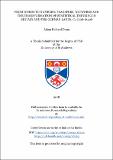Files in this item
From words to numbers : transfers, networks and the transformation of statistical thinking in Britain and the German lands, c. 1750s-1840s
Item metadata
| dc.contributor.advisor | Struck, Bernhard | |
| dc.contributor.author | Dunn, Adam Richard | |
| dc.coverage.spatial | ix, 236 p. | en_US |
| dc.date.accessioned | 2019-08-23T13:24:12Z | |
| dc.date.available | 2019-08-23T13:24:12Z | |
| dc.date.issued | 2019-12-04 | |
| dc.identifier.uri | https://hdl.handle.net/10023/18363 | |
| dc.description.abstract | This thesis explores the changes, evolution and developments of statistical thinking from the eighteenth to the nineteenth century. It maps how the perception, methodology and use of statistics shifted. It argues that statistical thought changed from a descriptive, narrative, mode to a more mathematical, scientific, and visual mode. Focusing on this evolution in Britain and the German lands this study explores the works of Sir John Sinclair and August Ludwig von Schlözer. It emphasises the crucial role of amateur statisticians, working beyond or on the margins of state mechanisms, in this development and explores an area that has been deeply neglected. It places these developments in a wider transnational framework to illuminate how networks, travels and transmission of texts between these amateur statisticians were pivotal to this evolution. The thesis argues that this evolution was founded in the works of these amateur statisticians whose ideas were born out of a number of different and intersecting trends. Their ideas increased in sophistication because they were marginal to the state and through their networks could spread more radical notions of statistical thought. By tracing these circulations and the connections of these men it highlights how their ideas became pivotal to the evolution in statistical thought and examines the transfer and transformation of these ideas and how they fit into the larger framework of statistics in the eighteenth and nineteenth century. By highlighting the role of the individual and the vast transnational networks they established it illuminates how statistics evolved from a descriptive discipline that hid the mathematics behind dense narrative to a more mathematically minded, visual discipline, that sought to use tables, maps, and numbers to illustrate its findings. | |
| dc.description.sponsorship | "This work was supported by funding from the Herzog-Ernst-Scholarship Programme of the Fritz Thyssen Stiftung and a Doctoral Fellowship from the Leibniz-Institut für Europäische Geschichte." -- Funding | en |
| dc.language.iso | en | en_US |
| dc.publisher | University of St Andrews | |
| dc.subject.lcc | HA19.D8 | |
| dc.title | From words to numbers : transfers, networks and the transformation of statistical thinking in Britain and the German lands, c. 1750s-1840s | en_US |
| dc.type | Thesis | en_US |
| dc.contributor.sponsor | Fritz Thyssen Stiftung. Herzog-Ernst-Stipendium | en_US |
| dc.contributor.sponsor | Leibniz-Institut für Europäische Geschichte | en_US |
| dc.type.qualificationlevel | Doctoral | en_US |
| dc.type.qualificationname | PhD Doctor of Philosophy | en_US |
| dc.publisher.institution | The University of St Andrews | en_US |
| dc.publisher.department | University of St Andrews | en_US |
| dc.identifier.doi | https://doi.org/10.17630/10023-18363 |
This item appears in the following Collection(s)
Items in the St Andrews Research Repository are protected by copyright, with all rights reserved, unless otherwise indicated.

